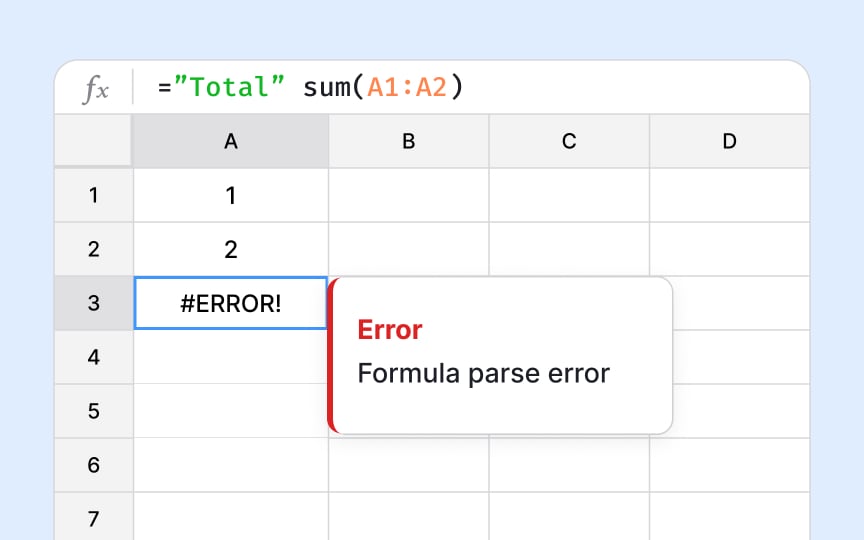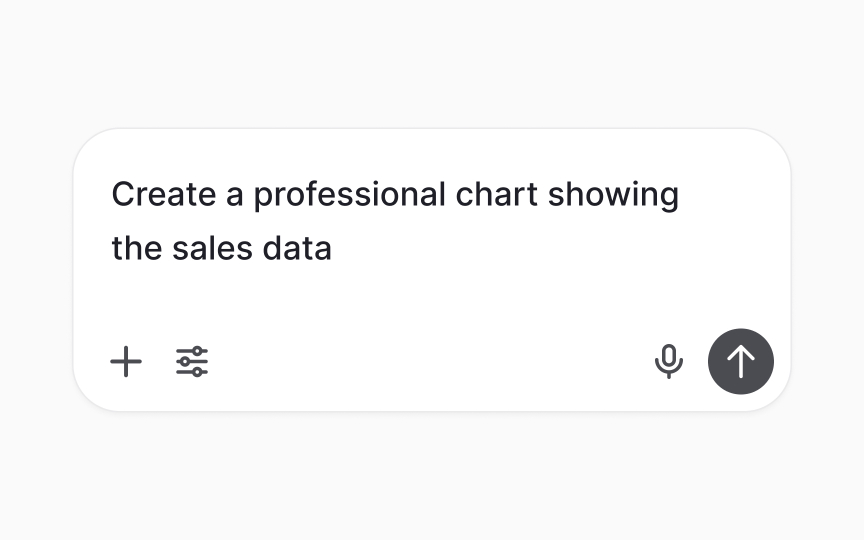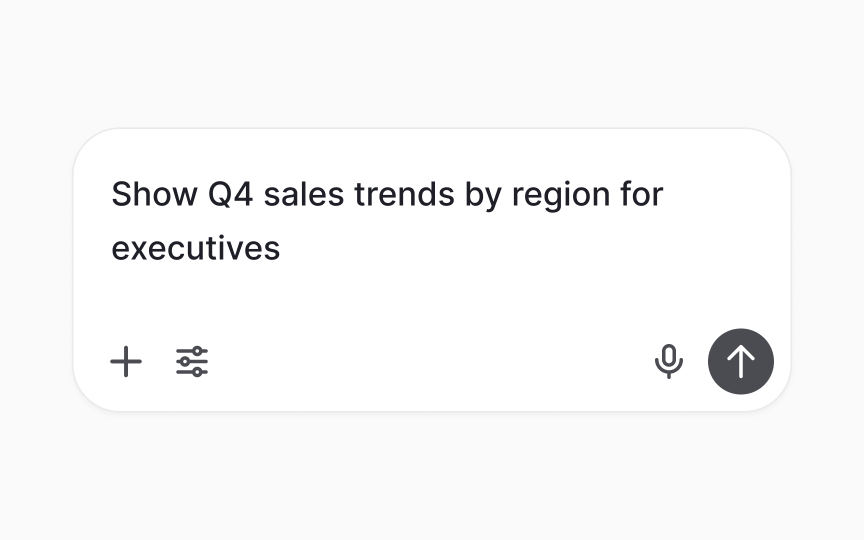Data Analysis with AI
Master the art of turning data analysis requests into clear AI prompts that deliver statistical insights, visualizations, and actionable recommendations.
Data guides every product decision, but getting useful insights usually needs special technical skills. Artificial intelligence changes this completely. AI tools can understand plain language and turn your questions into analysis results. These tools are great at finding patterns, doing math calculations, and creating charts. This makes complex analysis available to anyone who can explain what they need.
The secret is learning how to tell AI exactly what you want to analyze. You can explore data files, create visual charts, and find important trends just by asking the right questions. AI becomes your analysis partner that understands what you're looking for. But this power comes with responsibility. When working with private or sensitive data, you must be careful about security.
AI analysis has limits too. Knowing these limits helps you avoid wrong conclusions and get reliable results. The goal is to use AI's strengths while always double-checking important findings. When used wisely, AI becomes a powerful tool that helps you make better decisions. It turns confusing data into clear insights that improve your products.
Working with large datasets can feel overwhelming. Hundreds of rows, multiple columns, and hidden patterns make it hard to know where to start.
Start by asking AI to show you what's in your dataset. Request a summary of columns, data types, and sample values. Ask about missing data or unusual patterns. AI can count unique values, show data ranges, and identify potential issues. This initial exploration reveals the dataset's structure and quality. The key is being specific about what you want to see. Rather than asking "analyze this data," try "show me the first 10 rows and describe each column's purpose." Or request "identify columns with more than 20% missing values." These targeted questions yield useful insights quickly.
Remember that AI needs context. Explain what the data represents and your analysis goals. This helps AI provide relevant suggestions and spot meaningful patterns you might miss.
Pro Tip: Always start by asking AI to describe the dataset's structure before diving into specific analysis tasks.
User behavior patterns hide in your data, waiting to reveal valuable insights.
Effective pattern detection requires clear questions. Instead of asking for "all patterns," focus on specific areas. Try prompts like "identify the most common paths users take before purchasing" or "find behavior differences between new and returning users." This focused approach yields actionable insights. AI can also detect unusual behaviors that might indicate problems or opportunities. It compares individual users against typical patterns, flagging outliers for investigation. These exceptions often reveal important edge cases or emerging trends.
Pro Tip: Ask AI to segment users by behavior patterns before analyzing each group separately for deeper insights.
Statistical analysis forms the backbone of data-driven decisions.
Common statistical requests include averages, medians, standard deviations, and percentiles. But AI goes beyond basics. It can perform regression analysis, hypothesis testing, and confidence interval calculations. The trick is knowing what to ask for and when each measure matters. Frame your requests clearly. Instead of "do statistics on this column," specify "calculate the mean, median, and standard deviation of order values." For deeper analysis, try "perform a correlation analysis between user age and purchase frequency." If unsure about terminology, describe your goal: "I want to know if older users buy more frequently." AI suggests the right statistical approach.
Don't worry if statistical terms feel foreign. AI understands plain language descriptions of what you want to know. Instead of requesting "standard deviation," you can ask "How spread out are these values?" Rather than "correlation coefficient," try "do these two things tend to happen together?" AI translates your everyday questions into appropriate statistical analyses. AI also explains what these numbers mean. It can interpret statistical significance, describe distributions, and suggest which tests suit your data. This educational aspect helps you understand results, not just generate them. Always verify critical calculations independently.
Pro Tip: Ask AI to explain which statistical measure best answers your specific question before running calculations.
Spreadsheet formulas break for countless reasons. Missing parentheses, incorrect cell references, or mismatched data types create frustrating errors.
Beyond fixing errors, AI helps you understand why formulas fail. It explains each component, shows how data flows through calculations, and identifies edge cases. This knowledge prevents future mistakes and builds your formula-writing skills.
AI can also suggest alternative approaches. Sometimes a complex nested formula works better as multiple simple steps. Or built-in functions might replace custom calculations. These suggestions often lead to more maintainable spreadsheets that others can understand and modify.
Pro Tip: Include sample data and expected results when asking AI to debug formulas for more accurate solutions.
Messy data slows analysis and increases
Common optimizations include normalizing data formats, creating consistent naming conventions, and establishing clear relationships between tables. AI can generate step-by-step transformation plans. It also warns about potential data loss during restructuring.
Think beyond immediate needs. AI helps design structures that scale with growing data and accommodate future analysis requirements. It suggests index columns, identifies natural groupings, and recommends backup strategies. Good organization pays dividends as datasets expand over time.
Data visualizations transform numbers into stories. But choosing the right chart type and design requires understanding both data and audience.
- Data description: What data you have
- Key message: What story it should tell
- Audience: Who will see it
- Context: Where it appears
This information shapes every design decision. Be specific about visualization goals. Instead of requesting "a chart," try "create a line graph showing monthly revenue trends with annotations for major product launches." Include preferences for colors, labels, and formatting. These details ensure outputs match your needs. AI suggests appropriate chart types based on your data and message. It knows when bar
Pro Tip: Always specify your audience's technical level when requesting visualizations to ensure appropriate complexity.
Raw data contains stories waiting to be discovered.
Insight extraction works best with guided exploration. Share your business context and current challenges. AI then focuses on relevant findings rather than listing every possible observation. Quality beats quantity when presenting insights to stakeholders.
Prompt AI to prioritize discoveries. Ask for "3 most significant trends" or "factors most strongly correlated with customer churn." This filtering ensures you focus on actionable findings rather than drowning in minor details. AI also connects insights across different data sources. It might be noticed that user behavior patterns align with seasonal trends, or that feature usage correlates with retention rates. These connections often reveal opportunities invisible when analyzing data in isolation.
Pro Tip: Request both positive and negative insights to get a balanced view of your data story.
Dirty data produces unreliable insights. Before any analysis, datasets need cleaning. Duplicates, missing values, formatting inconsistencies, and
Pro Tip: Save original data before cleaning and ask AI to document all transformations for reproducibility.
Working with personal or confidential data requires extreme care.
AI can help create safe analysis strategies. It suggests anonymization techniques, generates synthetic datasets, and identifies potentially sensitive combinations. Even seemingly harmless data can become identifying when combined. AI spots these risks.
Document your data handling practices. AI helps create privacy policies and audit logs. It ensures compliance with regulations like GDPR or CCPA. When unsure about data sensitivity, err on the side of caution. The cost of privacy breaches far exceeds any analytical benefits.
Top contributors
Topics
From Course
Share
Similar lessons

AI’s Role in Text Generation and Modification

Best Practices and Potential Pitfalls of AI Writing Tools





















